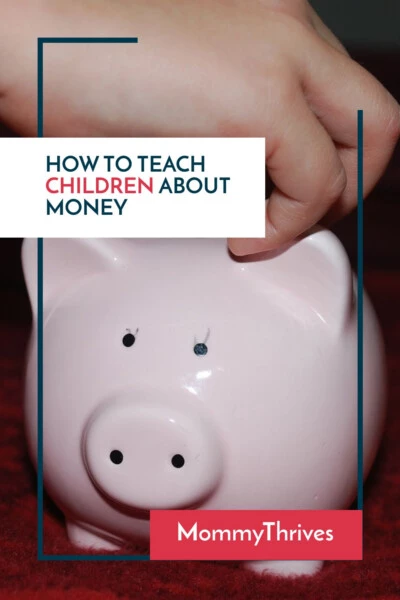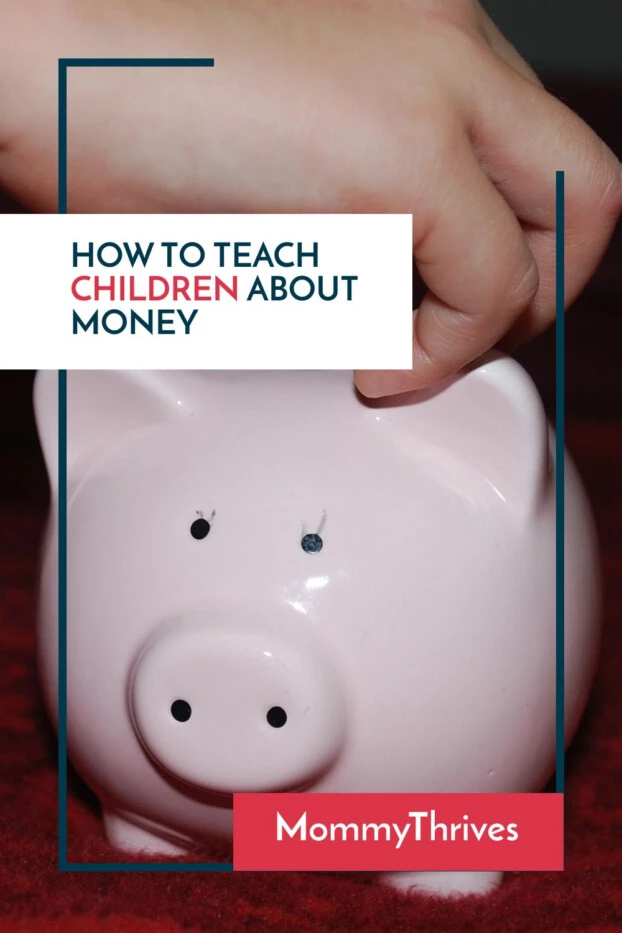What is your relationship with money? Does it drive your every move, or come and go without a care? How you manage money now is a strong indicator of how your children will manage their own finances one day.
I have four, young daughters and like every parent I’m bombarded with requests (ie demands) to buy them stuff. But, stuff costs money. And, money trees don’t grow in our cold, wintry climate (I’m Canadian). So, sorry girls, instead you’re going to have to learn some valuable financial lessons.
The following is a list of the best ideas, every parent can use, about how to teach children about money.
In this article, you’ll learn how to create an ongoing conversation about money at your house. As well, we’ll look at the best tips to help your kids learn about money at every age – from toddler to teenager.

How To Begin Teaching Kids About Money
1. Start Talking Money At A Young Age
Money habits start young. The habits your kids develop now will shape their relationship with money into their adult lives.
So, it is important that you start talking to your children about money concepts at a young age. Then you can build upon their knowledge as they grow.
The benefits of starting your children’s money education early include helping them to:
- Make smart decisions about spending
- Save for their future
- Learn about debt and credit
- Understand the difference between needs and wants
2. Make Money-Talk An Everyday Thing
Use everyday life experiences to teach your child about money. You want your child to become familiar with financial words and concepts.
You can use day-to-day activities, like grocery shopping, to start a conversation about:
- How to decide what items to buy
- How to compare the prices of different brands
- If buying a food in bulk is a better deal
- How you are going to pay the grocery bill (cash, debit, credit)
My 7 and 9-year-old daughters really like to use their math skills to comparison shop. Asking them to find the lowest price on a box of diapers for their baby sister involves them in our errands and teaches them to think about saving money.
Here are some other practical ways you can turn shopping into a math lesson:
- If you are cutting coupons or using a price-matching app, ask your children to find the on-sale items.
- Compare the costs of similar products with different brand names
- Calculate whether the item in bulk is really a better deal
3. Talk About Needs Versus Wants
Explain to your child the difference between things they need and things they want. First, the family spends money on the items you need, such as food and shelter. After paying for the things you need, you can see if you can afford the things you want.
However, it is important that you don’t spend all your money. Saving for special “want” items, like a family vacation, takes time.
Teaching children the difference between a need and a want will help them to make good spending choices:
Spending money is about making choices. For example, if they spend their money on a new toy, they won’t have enough to purchase the book they want.
4. Talk About Where Money Comes From
Knowing where the money comes from can be a tricky concept for young children. They may see you going to the bank to take out cash, but they might not realize that the cash is not “free”.
My 5-year-old daughter used to believe that the bank would just give me money whenever I wanted. I wish!
I had to explain to her several times that money comes from the following sources:
- A salary that I earn by going to work
- From government social programs (Canada Child Benefit)
- From my savings account

Age-By-Age Guide to Teaching Kids About Money
Managing money is a skill many adults haven’t yet mastered. Teaching young kids the basics will help them become responsible adults.
How to Teach Kids 6 and Under About Money
1. Use A Piggy Bank and Count The Change
A piggy bank is your child’s first savings account! Allow them to put their own coins through the slot and hear the “clink” as their money hits bottom. Kids love emptying out the money and separating the coins into piles. Repeatedly counting the money as their piggy bank puts on pounds teaches them about savings, and doubles as a great math activity.
2. Let Them Handle Cash and Pay For Their Own Purchases
Let your child carry some of their tooth fairy money and birthday cash to the store to buy something they want. My kids enjoy deciding at home how much they want to spend and carrying their own money to the store in a Ziploc bag. After deciding on a toy or book, let your kid go through the check-out and make the transaction.themselves. Kids quickly learn to respect money when they’re spending their own.
3. Monkey-see, Monkey-do
Isn’t it astonishing when you hear your child utter the exact same turn-of phrase you always use? Yes, those little ears are always listening and the same holds true for those eyes. Setting a good example when it comes to money means showing them good saving and spending habits.
This can include making a grocery list and sticking to it or not giving in when you child “just has to” have that new, cool Lego kit.
How To Teach Kids Age 7 To 12 Years Old About Money
1. Give Kids An Allowance
Now is the age when kids can begin helping out more around the house. In addition to cleaning up after themselves, your child can help with doing the laundry, dusting, or weeding the garden. When allowance day comes around, make a point of listing all the ways that they earned their money that week. Your child will gain a sense of independence and pride for working for a reward.
2. Make A List Of What You Are Going To Buy And Stick To It
Teach your child that not every trip to the store results in buying something for them. And, yes, this will probably mean a meltdown or two (or 11) in the store. Stick to your guns and they will get the idea that mom and dad aren’t going to crack and give in to their demands.
Before setting out to the mall, let your kids know that “we are only going to buy new towels”, and then don’t give in if they beg for a video game.
3. Separate Money Gifts Into Spend, Save, And Donate
My mom gets all the credit for starting my children off learning how to donate to charity. Each Christmas, grandma gives them cash gifts in separate envelopes marked, Spend, Save, and Donate. I was surprised at first by how carefully they weighed what cause they were going to put their Donate money towards. Dividing their money into these categories teaches them to prioritize saving and about generosity towards others.
4. Help Your Child Open A Savings Account
As your child gets into their pre-teen years, chances are they’ve outgrown their piggy bank. Now is the time to help them open their own bank account to hold their savings. They will enjoy watching their account balance grow. If you don’t feel they are ready yet for the responsibility of their own account, have them contribute some money into their College Savings Plan.
Related Article: What Age Should A Child Open A Bank Account?
How To Teach Kids 13+ About Money
1. Time To Get A Part-time Job
Just like receiving an allowance, working a part-time job teaches kids that money is earned and saving it now will help them afford the things they want in the future. Babysitting jobs or newspaper routes are good starter jobs for younger teens. Once they reach their mid-teens, teenagers are ready to spend their summers and weekends stocking shelves or serving food in a restaurant. Earning a paycheck also teaches kids about income taxes, minimum wage, and how a post-secondary education will increase their future salary.
2. Make A Savings Plan For Big Ticket Items
Now is the time your teenage child is ready to learn how to make a budget and start saving for big expenses such as buying a car or paying for college. Help your child research how much it is going to cost to attend college or university. Help them figure out how much money they need to save working during their summers to pay for college. Don’t forget to research any scholarship opportunities as well.
Knowledge is power, and by understanding what it is going to cost to reach their goals, kids will be motivated to save-up now. This is also a good opportunity to teach them about investing and earning compound interest on their money. Show them a compound interest money chart to show them how small monthly contributions at their age can grow into millions of dollars and help them retire early.
Related Article: How To Make A Family Budget
3. Consider Contributing To Your Child’s Savings Account
You may want to match the amount of money your child is putting away as a way to encourage them to reach their savings goals. For example, you might agree to pay for half the cost of the new cell phone they want to buy. Your child may be more excited to save up their own money quickly by watching their account balance increase with your help.
4. Teach Teenagers The Dangers Of Credit Cards
Once your teenager heads off to college or into the working world, they will be inundated with offers from credit card companies. Better they learn now how to pay off a credit card balance each month and the dangers of high interest rates. Having their own credit card will also teach them how to track their spending, make purchases online, and earn reward points.
Get your child a low-limit credit card, with a maximum limit of a few hundred dollars. That way if they get in over their head the damage is minimal. Plus, it will be a good lesson for when they are older and qualify for higher-limit cards. The card will most likely have to be in your name so you can cut it up if necessary.
Final Thoughts
By the time your kid is ready to leave the nest, the goal is to set them up with healthy money habits. By starting at a young age, and building up their knowledge as they grow, they will have the tools they need to make smart money-moves well into adulthood.
Related Posts:
- How To Do Child Led Reading To Teach Your Child To Read
- How To Actually Deal With A Picky Eater
- How To Set Up A Homeschool Space
- How To Know If Homeschool Is Right For Your Kid

